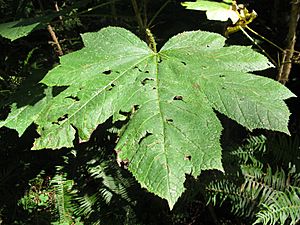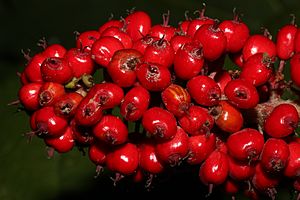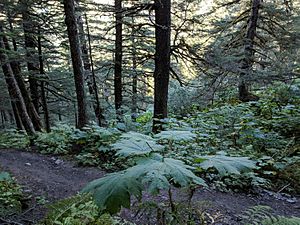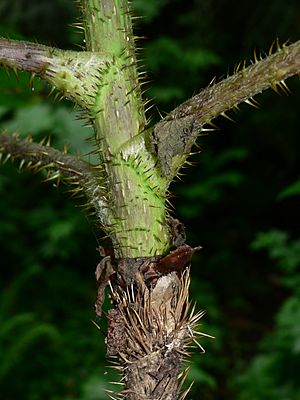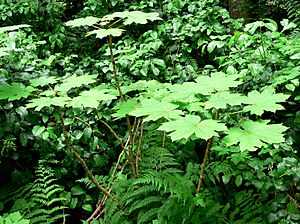Devil's club facts for kids
Quick facts for kids Devil's club |
|
|---|---|
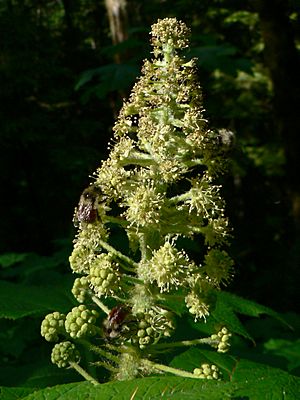 |
|
| Flowers and bumblebees | |
| Scientific classification | |
| Genus: |
Oplopanax
|
| Species: |
horridus
|
| Synonyms | |
|
Echinopanax horridum |
|
Devil's club (also called devil's walking stick) is a large, spiky plant that grows in the cool, wet forests of the Pacific Northwest. Its scientific name is Oplopanax horridus. This plant is famous for its big leaves and stems covered in sharp, irritating spines. People sometimes call it Alaskan ginseng, but it's not a true ginseng plant.
| Top - 0-9 A B C D E F G H I J K L M N O P Q R S T U V W X Y Z |
What Does Devil's Club Look Like?
Devil's club usually grows about 1 to 1.5 meters (3 to 5 feet) tall. But in very wet and untouched forest areas, it can reach heights of 3 to 5 meters (10 to 16 feet) or even more!
Its leaves are large, about 20 to 40 centimeters (8 to 16 inches) wide, and shaped like a hand with 5 to 13 points. These leaves grow in a spiral pattern around the stem. Both the leaves and stems are covered in sharp, yellow spines. These spines break off easily if you touch the plant, which can be quite irritating.
The plant also produces small, greenish-white flowers that grow in dense clusters. Later, these flowers turn into small, shiny red berries, each about 4 to 7 millimeters (0.15 to 0.27 inches) wide.
Devil's club grows slowly and takes many years to produce seeds. This means it's very sensitive to human activities like logging or development, because it doesn't grow back quickly.
Where Does Devil's Club Grow?
This plant loves to grow in moist, thick forests, especially in old-growth conifer forests in the Pacific Northwest. You can find it from southcentral Alaska down to Oregon, and as far east as western Alberta and Montana.
Interestingly, you can also find Devil's club far away from these main areas, on islands in Lake Superior. These include Isle Royale and Passage Island in Michigan, and Porphyry Island and Slate Island in Ontario.
How Does Devil's Club Spread?
Devil's club spreads by growing underground stems called rhizomes. These rhizomes can send up new shoots, creating what looks like many separate plants. However, all these plants might actually be connected underground, forming one large group! Over time, these new plants can grow their own roots and become independent.
How Have People Used Devil's Club?
Native American peoples, like the Tlingit, Tsimshian, and Haida in Alaska and British Columbia, have used Devil's club for many years.
- Traditional Medicine: They used it as a traditional medicine for different health issues, such as helping with conditions like diabetes and rheumatoid arthritis. They would prepare it as a tea or make ointments and poultices (a soft, moist mass applied to the body).
- Ceremonial Uses: The charcoal from the plant's stalks was used to make special face paints for ceremonies and protection. Hanging a piece of Devil's club over a doorway was believed to keep away bad spirits.
- Other Uses: Some Native American groups also dried and powdered the bark to use as a deodorant. The mashed berries were even used to clean hair!
Because Devil's club is related to American ginseng, some people try to sell it as "Alaskan ginseng." However, even though they look a bit similar, these plants are chemically different.
What About Research on Devil's Club?
Scientists have studied Devil's club to learn more about its properties. One study showed that certain parts of Devil's club might help fight tuberculosis in lab tests. Another study suggested it could help reduce certain types of acute myeloid leukemia cells in mice.


